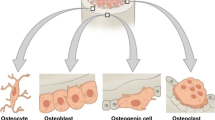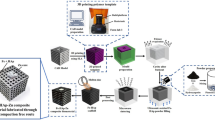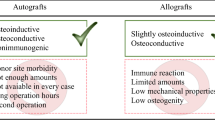Abstract
In a minimally invasive surgery, using a bone cement being radiologically detectable is vital to the success of the procedure and avoiding cement leakage in the early stage. The radiopacity of calcium phosphate cement (CPC) is inadequate, thus limiting its clinic application in this area. In this work, bismuth aluminate (BiA) was employed as a radiopaque agent for CPC. The influences of BiA on physicochemical, radiopaque and in vitro biocompatible properties of CPC were investigated. With the increasing content of BiA, the setting time and the compressive strength of CPC were augmented, while the injectability of the cement pastes was reduced. The radiopacity of CPC was significantly improved by adding more than 6 wt.% BiA. CPC specimens with less than 12 wt.% BiA showed good cellular affinity. Moreover, the CPC containing 6 and 9 wt.% BiA promoted the cell growth and ALP activity of mouse bone marrow mesenchymal stem cells when compared with the control. On the basis of its improved radiopacity and cytocompatibility, the radiopaque CPC with 6 ~ 9 wt.% BiA is expected to be a potential substitute for bone defect restoration via minimally invasive surgery.

CPC with bismuth aluminate reveals better radiopacity and cell affinity along with proper physicochemical properties.






Similar content being viewed by others
References
Dublin AB, Hartman J, Latchaw RE, Hald JK, Reid MH. The vertebral body fracture in osteoporosis: restoration of height using percutaneous vertebroplasty. Ajnr Am J Neuroradiol. 2005;26:489–92.
Pontiroli L, Dadkhah M, Novajra G, Tcacencu I, Fiorilli S, Vitale-Brovarone C. An aerosol-spray-assisted approach to produce mesoporous bioactive glass microspheres under mild acidic aqueous conditions. Mater Lett. 2017;190:111–4.
Wardlaw D, Cummings SR, Van Meirhaeghe J, Bastian L, Tillman JB, Ranstam J et al. Efficacy and safety of balloon kyphoplasty compared with non-surgical care for vertebral compression fracture (FREE): a randomised controlled trial. Lancet. 2009;373:1016–24.
Zou J, Mei X, Zhu X, Shi Q, Yang H. The long-term incidence of subsequent vertebral body fracture after vertebral augmentation therapy: a systemic review and meta-analysis. Pain Physician. 2012;15:E515–22.
Hernández L, Fernández M, Collía F, Gurruchaga M, Goñi I. Preparation of acrylic bone cements for vertebroplasty with bismuth salicylate as radiopaque agent. Biomaterials. 2006;27:100–7.
Grafe IA, Baier M, Noeldge G, Weiss C, Da Fonseca K, Hillmeier J et al. Calcium-phosphate and polymethylmethacrylate cement in long-term outcome after kyphoplasty of painful osteoporotic vertebral fractures. Spine. 2008;33:1284–90.
Khairoun I, Driessens FCM, Boltong MG, Planell JA, Wenz R. Addition of cohesion promotors to calcium phosphate cements. Biomaterials. 1999;20:393–8.
Lu JX, Descamps M, Dejou J, Koubi G, Hardouin P, Lemaitre J et al. The biodegradation mechanism of calcium phosphate biomaterials in bone. J Biomed Mater Res. 2002;63:408–12.
Thormann U, Ray S, Sommer U, ElKhassawna T, Rehling T, Hundgeburth M et al. Bone formation induced by strontium modified calcium phosphate cement in critical-size metaphyseal fracture defects in ovariectomized rats. Biomaterials. 2013;34:8589–98.
Heini PF, Wälchli B, Berlemann U. Percutaneous transpedicular vertebroplasty with PMMA: operative technique and early results. a prospective study for the treatment of osteoporotic compression fractures. Eur Spine J. 2000;9:445–50.
Aringberg J, Pankotai E, Hulsart Billstrom G, Weszl M, Larsson S, Forster-Horvath C, Lacza Z, Engqvist H. In vivo evaluation of an injectable premixed radiopaque calcium phosphate cement. International Journal of Biomaterials. 2011;2011:232574.
Sabokbar A, Fujikawa Y, Murray DW, Athanasou NA. Radio-opaque agents in bone cement increase bone resorption. J Bone Jt Surg-Br Vol. 1997;79B:129–34.
Wang X, Ye J, Wang Y. Influence of a novel radiopacifier on the properties of an injectable calcium phosphate cement. Acta Biomater. 2007;3:757–63.
Aguilar FG, da Fonseca Roberti Garcia L, Rossetto HL, Pardini LC, de Carvalho F. Panzeri Pires-de-Souza. Radiopacity evaluation of calcium aluminate cement containing different radiopacifying agents. J Endod. 2011;37:67–71.
Antonijevic D, Medigovic I, Zrilic M, Jokic B, Vukovic Z, Todorovic L. The influence of different radiopacifying agents on the radiopacity, compressive strength, setting time, and porosity of Portland cement. Clin Oral Investig. 2014;18:1597–604.
Baleani M, Viceconti M. The effect of adding 10% of barium sulphate radiopacifier on the mechanical behaviour of acrylic bone cement. Fatigue & Fract Eng Mater & Struct. 2011;34:374–82.
Artola A, Gurruchaga M, Vázquez B, San Román J, Goñi I. Elimination of barium sulphate from acrylic bone cements. Use two Iodine-Contain Monomers Biomater. 2003;24:4071–80.
Khaled SMZ, Charpentier PA, Rizkalla AS. Synthesis and characterization of poly(methyl methacrylate)-based experimental bone cements reinforced with TiO2–SrO nanotubes. Acta Biomater. 2010;6:3178–86.
Martinez de Arenaza I, Sadaba N, Larranaga A, Zuza E, Sarasua JR. High toughness biodegradable radiopaque composites based on polylactide and barium sulphate. Eur Polym J. 2015;73:88–93.
Furtos G, Baldea B, Silaghi-Dumitrescu L. Development of new radiopaque glass fiber posts. Mater Sci Eng: C. 2016;59:855–62.
Bosso-Martelo R, Guerreiro-Tanomaru JM, Viapiana R, Berbert FLC, Hungaro Duarte MA, Tanomaru-Filho M. Physicochemical properties of calcium silicate cements associated with microparticulate and nanoparticulate radiopacifiers. Clin Oral Investig. 2016;20:83–90.
Li Q, Deacon AD, Coleman NJ. The impact of zirconium oxide nanoparticles on the hydration chemistry and biocompatibility of white Portland cement. Dent Mater J. 2013;32:808–15.
Kim E-C, Lee B-C, Chang H-S, Lee W, Hong C-U, Min K-S. Evaluation of the radiopacity and cytotoxicity of Portland cements containing bismuth oxide. Oral Surg Oral Med Oral Pathol Oral Radiol Endodontology. 2008;105:E54–7.
Hwang Y-C, Lee S-H, Hwang I-N, Kang I-C, Kim M-S, Kim S-H et al. Chemical composition, radiopacity, and biocompatibility of Portland cement with bismuth oxide. Oral Surg Oral Med Oral Pathol Oral Radiol Endodontology. 2009;107:E96–102.
Salarian M, Xu WZ, Bohay R, Lui EMK, Charpentier PA. Angiogenic Rg(1)/Sr-Doped TiO2 Nanowire/Poly(Propylene Fumarate) Bone Cement Composites. Macromol Biosci. 2017;17:1600156.
Lopez A, Montazerolghaem M, Engqvist H, Ott MK, Persson C. Calcium phosphate cements with strontium halides as radiopacifiers. J Biomed Mater Res Part B-Appl Biomater. 2014;102:250–9.
Ingham E, Green TR, Stone MH, Kowalski R, Watkins N, Fisher J. Production of TNF-α and bone resorbing activity by macrophages in response to different types of bone cement particles. Biomaterials. 2000;21:1005–13.
Deb S, Abdulghani S, Behiri JC. Radiopacity in bone cements using an organo-bismuth compound. Biomaterials. 2002;23:3387–93.
Amirouche A, Mouzali M, Watts DC. Radiopacity evaluation of bis-GMA/TEGDMA/opaque mineral filler dental composites. J Appl Polym Sci. 2007;104:1632–9.
Ricker A, Liu-Snyder P, Webster TJ. The influence of nano MgO and BaSO4 particle size additives on properties of PMMA bone cement. Int J Nanomed. 2008;3:125–32.
Briand GG, Burford. N. Bismuth compounds and preparations with biological or medicinal relevance. Chem Rev. 1999;99:2601–57.
Yang YJ, Shu E, Zhou Y. Influence on the properties of a calcium phosphate cement with bismuth phosphate as radiopaque agent. Bull Chin Ceram Soc. 2009;28:219–28.
Chen F, Liu C, Mao Y. Bismuth-doped injectable calcium phosphate cement with improved radiopacity and potent antimicrobial activity for root canal filling. Acta Biomater. 2010;6:3199–207.
Chen W-C, Hsu S-M, Ko J-H, Lin C-C, Lin D-J. Effects of bismuth subgallate on properties of calcium phosphate bone cement in vitro. J Med Biol Eng. 2014;34:8–13.
Webster TJ, Massa-Schlueter EA, Smith JL, Slamovich EB. Osteoblast response to hydroxyapatite doped with divalent and trivalent cations. Biomaterials. 2004;25:2111–21.
Selvakumar M, Srivastava P, Pawar HS, Francis NK, Das B, Sathishkumar G et al. On-demand guided bone regeneration with microbial protection of ornamented spu scaffold with bismuth-doped single crystalline hydroxyapatite: augmentation and cartilage formation. ACS Appl Mater Interfaces. 2016;8:4086–100.
Yang N, Sun H. Biocoordination chemistry of bismuth: Recent advances. Coord Chem Rev. 2007;251:2354–66.
Ouyang R, Yang Y, Tong X, Feng K, Yang Y, Tao H et al. Potent anticancer activity of a new bismuth (III) complex against human lung cancer cells. J Inorg Biochem. 2017;168:18–26.
Wang X, Ye J, Wang Y. Hydration mechanism of a novel PCCP+DCPA cement system. J Mater Sci: Mater Med. 2008;19:813–6.
Pekkan G, Aktas A, Pekkan K. Comparative radiopacity of bone graft materials. J Cranio-Maxillofac Surg. 2012;40:e1–e4.
Spriano S, Sarath Chandra V, Cochis A, Uberti F, Rimondini L, Bertone E et al. How do wettability, zeta potential and hydroxylation degree affect the biological response of biomaterials? Mater Sci Eng: C. 2017;74:542–55.
Rapuano BE, MacDonald DE. Surface oxide net charge of a titanium alloy modulation of fibronectin-activated attachment and spreading of osteogenic cells. Colloids Surf B-Biointerfaces. 2011;82:95–103.
Jeon H, Simon CG Jr., Kim G. A mini-review: cell response to microscale, nanoscale, and hierarchical patterning of surface structure. J Biomed Mater Res Part B-Appl Biomater. 2014;102:1580–94.
Zhang J, Shi HS, Liu JQ, Yu T, Shen ZH, Ye JD. Good hydration and cell-biological performances of superparamagnetic calcium phosphate cement with concentration-dependent osteogenesis and angiogenesis induced by ferric iron. J Mater Chem B. 2015;3:8782–95.
Zhang J, Ma X, Lin D, Shi H, Yuan Y, Tang W et al. Magnesium modification of a calcium phosphate cement alters bone marrow stromal cell behavior via an integrin-mediated mechanism. Biomaterials. 2015;53:251–64.
Boertz J, Hartmann LM, Sulkowski M, Hippler J, Mosel F, Diaz-Bone RA et al. Determination of trimethylbismuth in the human body after ingestion of colloidal bismuth subcitrate. Drug Metab Dispos. 2009;37:352–8.
William Lau KH, Yoo A, Wang SP. Aluminum stimulates the proliferation and differentiation of osteoblasts in vitro by a mechanism that is different from fluoride. Mol Cell Biochem. 1991;105:93–105.
Scrivener KL, Cabiron J-L, Letourneux R. High-performance concretes from calcium aluminate cements. Cem Concr Res. 1999;29:1215–23.
Hatten HP, Voor MJ. Bone Healing using a bi-phasic ceramic bone substitute demonstrated in human vertebroplasty and with histology in a rabbit cancellous bone defect model. Interv Neuroradiol. 2012;18:105–13.
Gbureck U, Barralet JE, Spatz K, Grover LM, Thull R. Ionic modification of calcium phosphate cement viscosity. Part I: hypodermic injection and strength improvement of apatite cement. Biomaterials. 2004;25:2187–95.
Torres PMC, Gouveia S, Olhero S, Kaushal A, Ferreira JMF. Injectability of calcium phosphate pastes: Effects of particle size and state of aggregation of β-tricalcium phosphate powders. Acta Biomater. 2015;21:204–16.
Bohner M, Baroud G. Injectability of calcium phosphate pastes. Biomaterials. 2005;26:1553–63.
Acknowledgements
This study was supported by the National Natural Science Foundation of China (NSFC) under Grant No. 51672087, the Science and Technology Program of Guangzhou City of China under Grant No. 201508020017 and the Fundamental Research Funds for the Central Universities.
Author information
Authors and Affiliations
Corresponding author
Ethics declarations
Conflict of interest
The authors declare that they have no conflict of interest.
Rights and permissions
About this article
Cite this article
Wu, T., Yang, S., Shi, H. et al. Preparation and cytocompatibility of a novel bismuth aluminate/calcium phosphate cement with high radiopacity. J Mater Sci: Mater Med 29, 149 (2018). https://doi.org/10.1007/s10856-018-6154-1
Received:
Accepted:
Published:
DOI: https://doi.org/10.1007/s10856-018-6154-1




